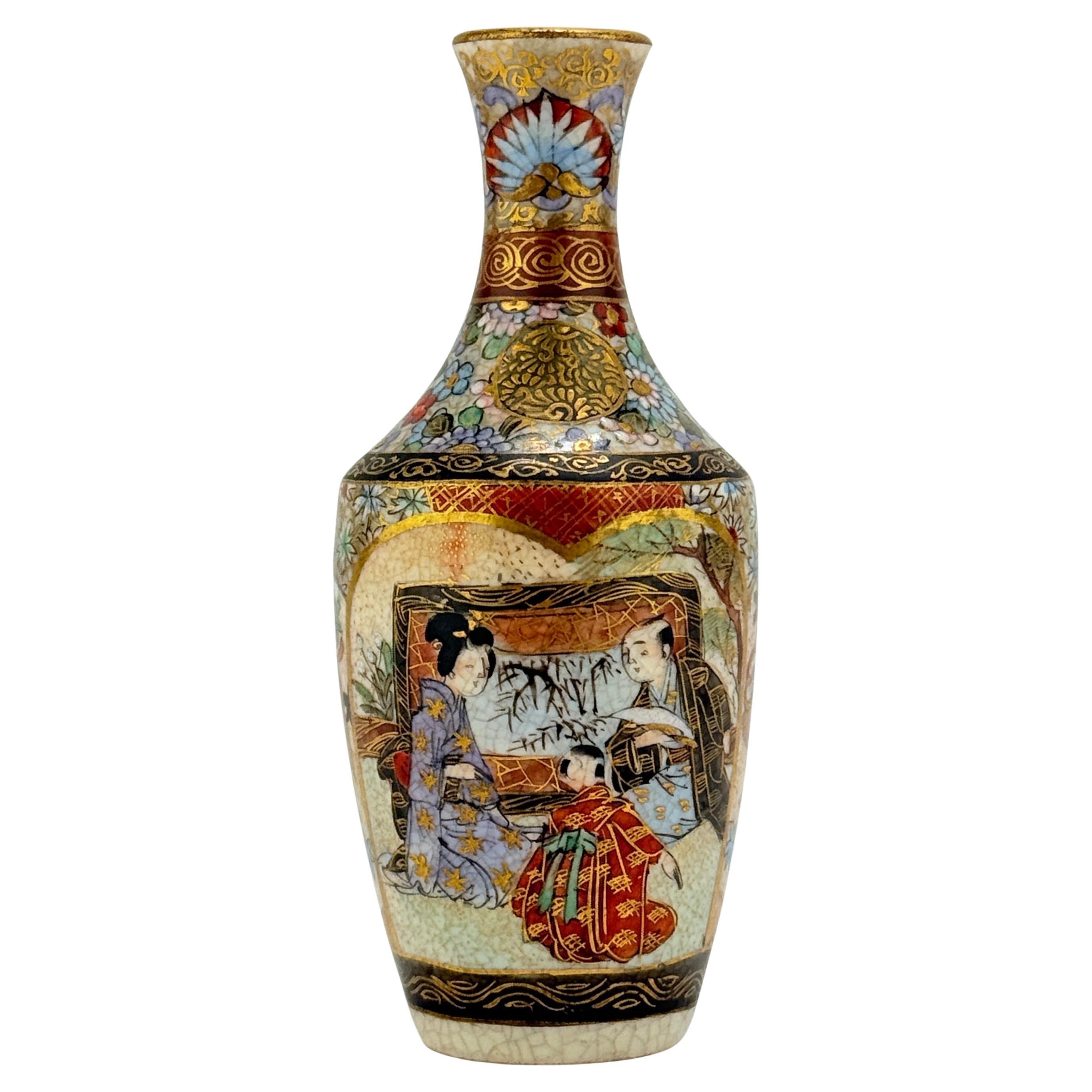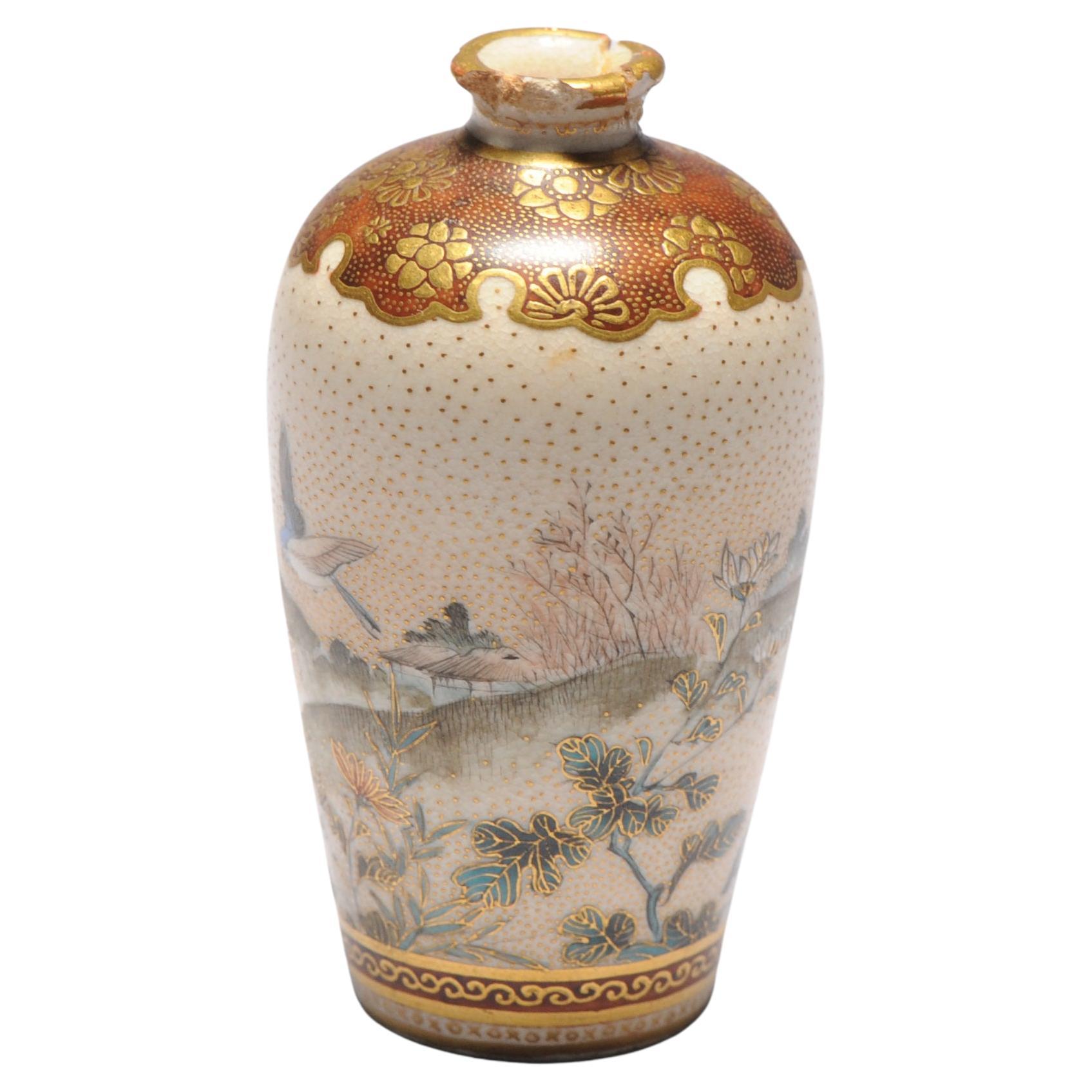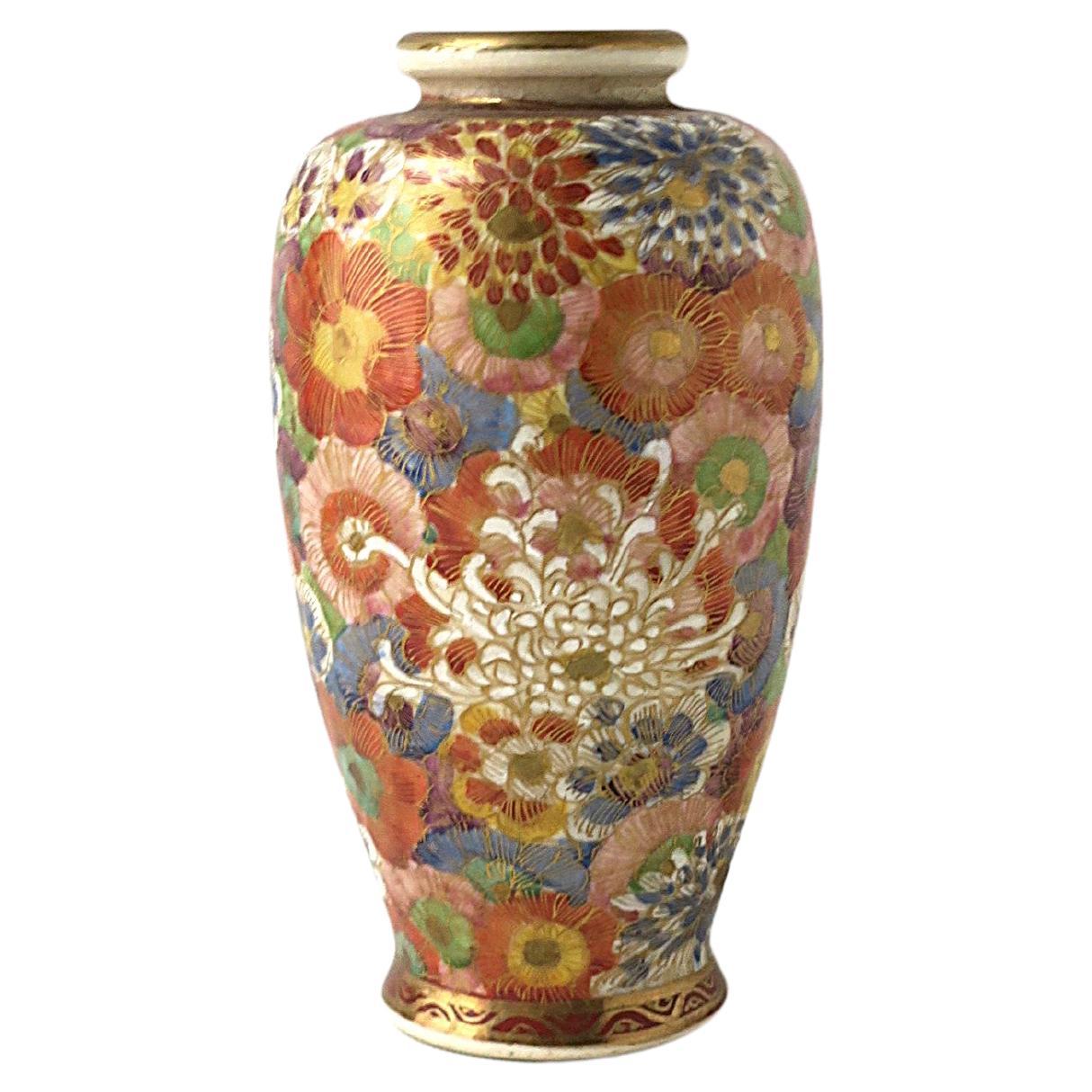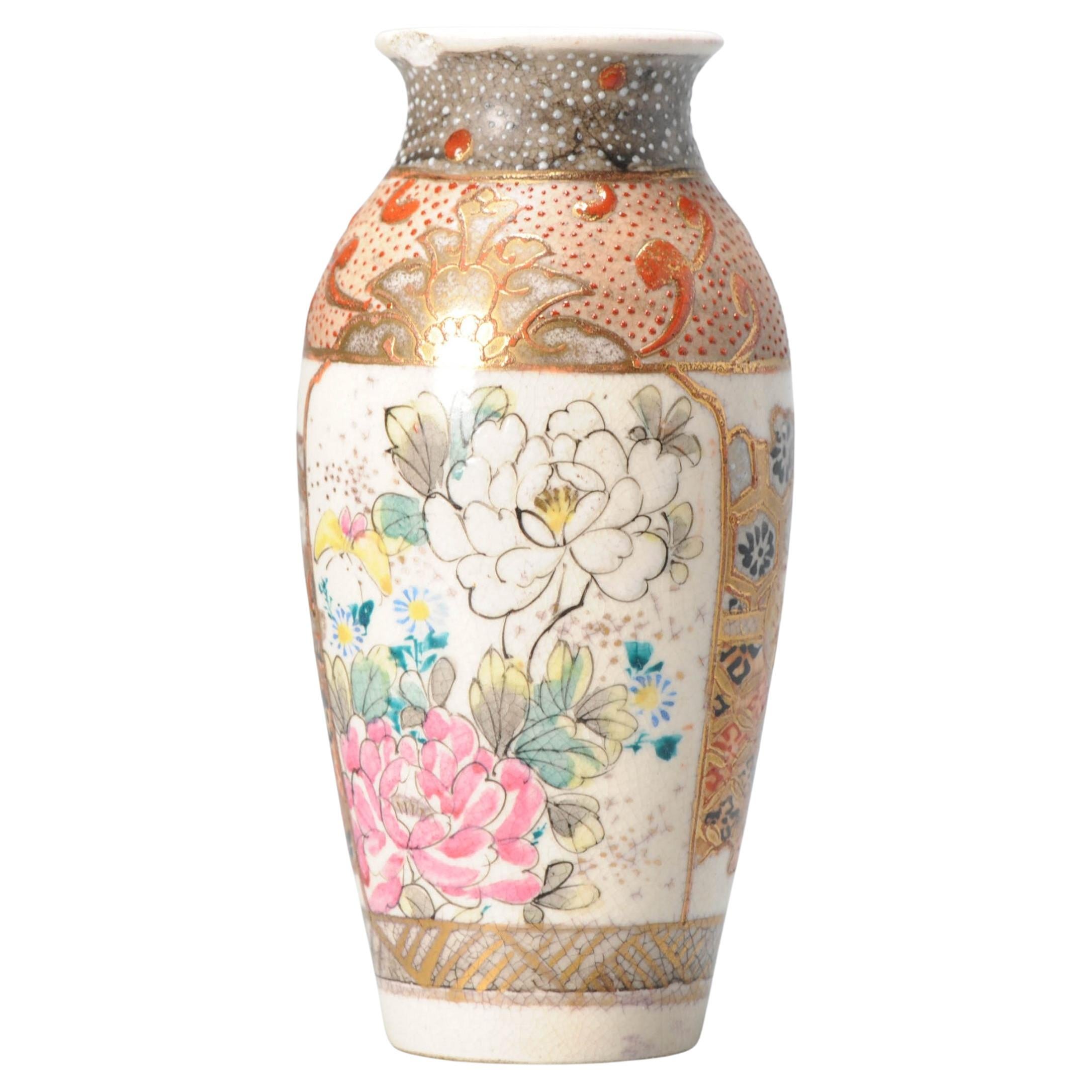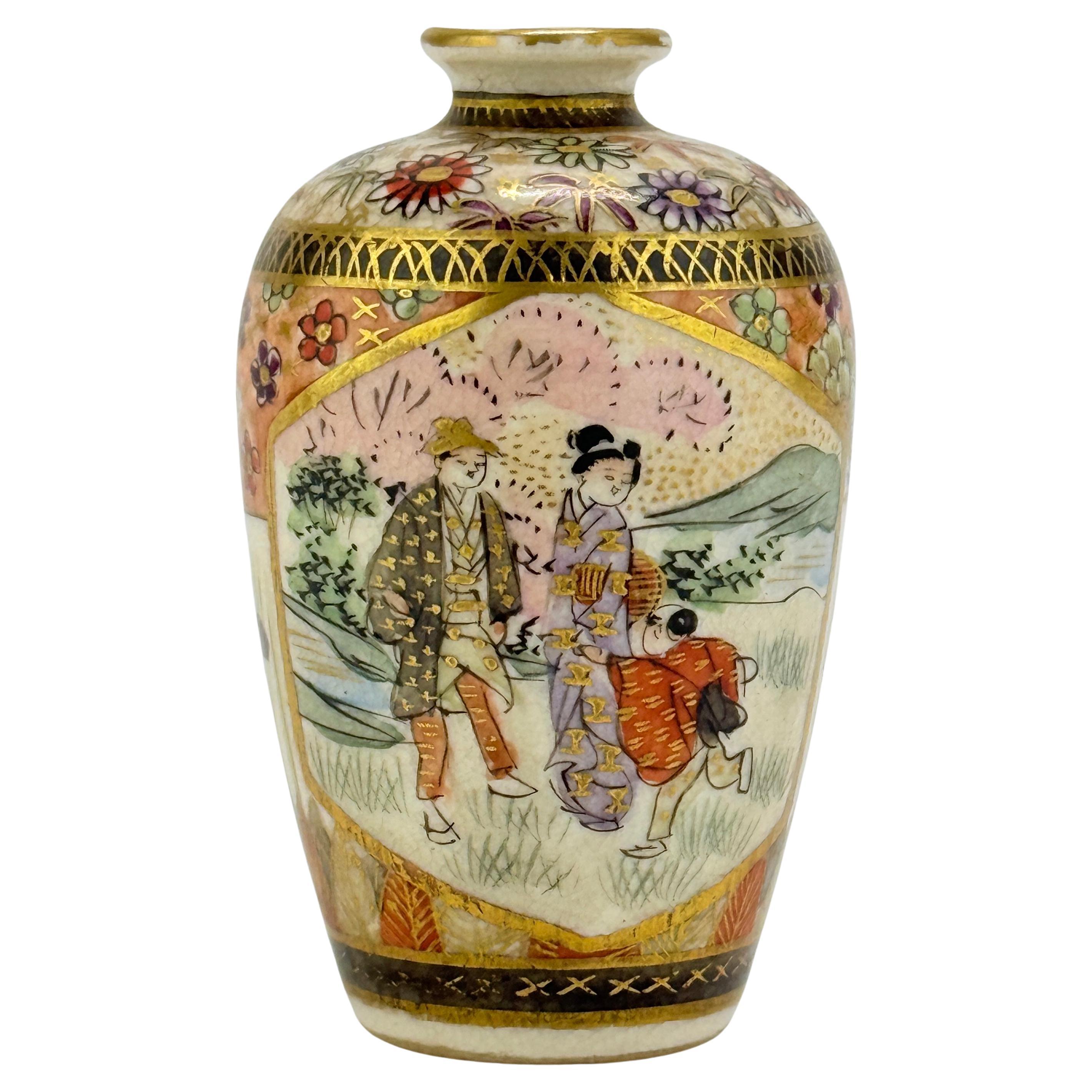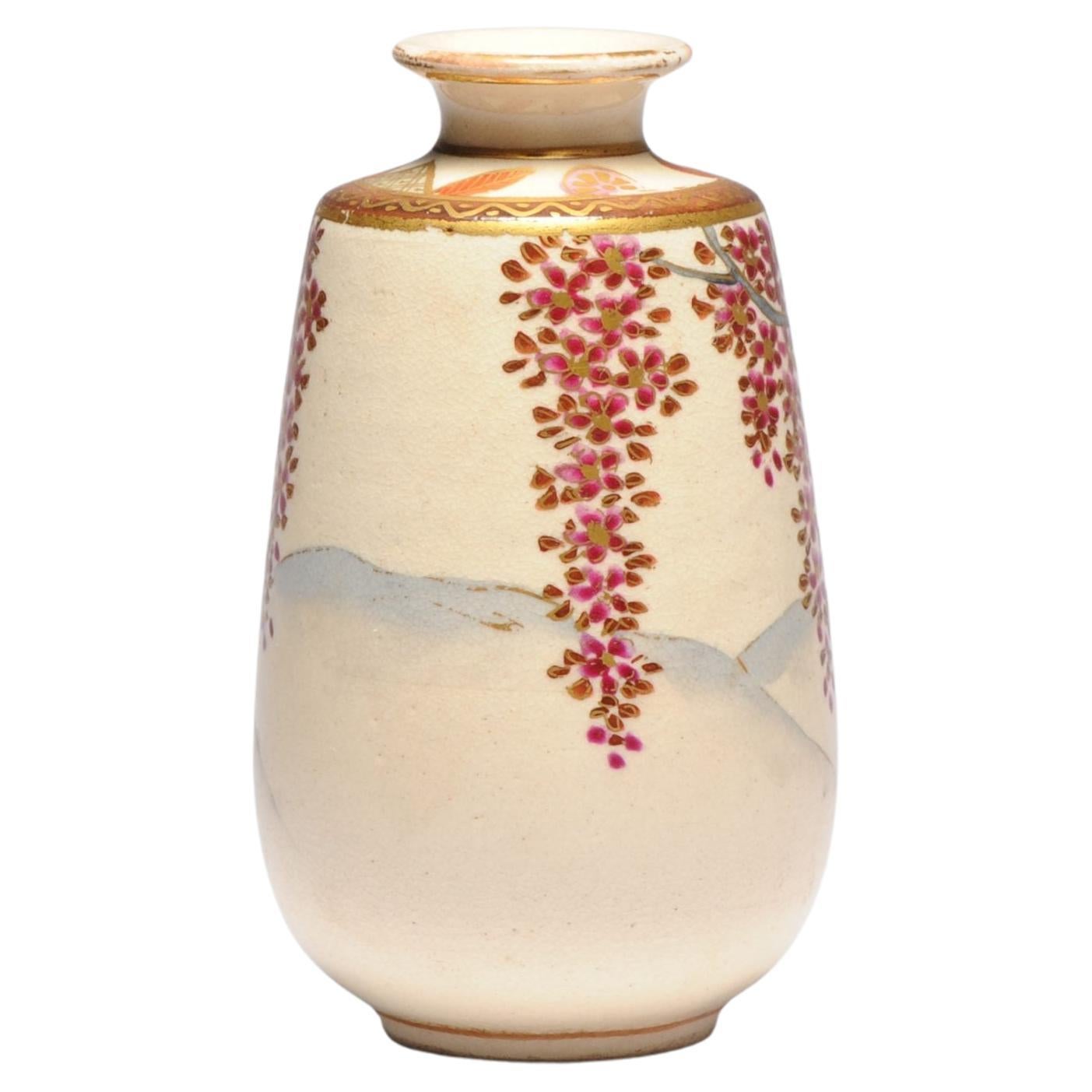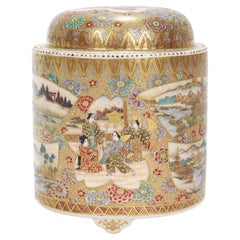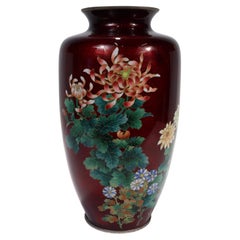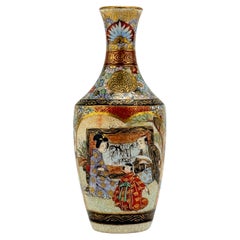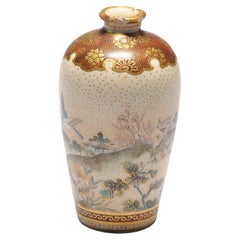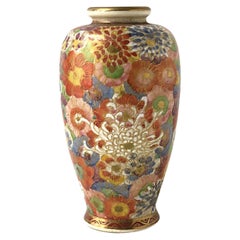Items Similar to Antique Japanese Satsuma Miniature Cabinet Vase
Want more images or videos?
Request additional images or videos from the seller
1 of 8
Antique Japanese Satsuma Miniature Cabinet Vase
$695
£515.72
€600.74
CA$967.45
A$1,077.34
CHF 560.69
MX$13,283.44
NOK 7,140.87
SEK 6,711.73
DKK 4,482.26
Shipping
Retrieving quote...The 1stDibs Promise:
Authenticity Guarantee,
Money-Back Guarantee,
24-Hour Cancellation
About the Item
A fine diminutive, antique Japanese Satsuma pottery cabinet vase.
Decorated throughout with gilding and raised enamel.
There are two cartouches on the vase decorated with red flowers (possibly peonies) and birds.
The mouth of the vase has a gilt ring.
Simply a wonderful Japanese vase!
Date:
Late 19th or Early 20th Century
Overall Condition:
It is in overall good, as-pictured, used estate condition with no chips, cracks, or repairs.
Condition Details:
There is fine and tight crazing throughout, some very minor rubbing to the gilding and light wear to the decoration, and a small firing flaw to the underside of the vase. Otherwise, there are some fine & light surface scratches here & there and other signs of expected light wear consistent with age.
Marks:
Unmarked
Measurements:
Height: ca. 59 mm
Diameter: ca. 53 mm
Items purchased from this dealer must delight you. Purchases may be returned for any reason for a period of 7 days.
- Similar to:Master Ryozan (Artist)
- Dimensions:Height: 2.33 in (5.9 cm)Diameter: 2.09 in (5.3 cm)
- Style:Meiji (In the Style Of)
- Materials and Techniques:
- Place of Origin:
- Period:
- Date of Manufacture:20th Century
- Condition:Wear consistent with age and use. See description for condition details.
- Seller Location:Philadelphia, PA
- Reference Number:Seller: DSA INV CH N211stDibs: LU1610226185902
About the Seller
5.0
Gold Seller
Premium sellers maintaining a 4.3+ rating and 24-hour response times
Established in 1996
1stDibs seller since 2015
528 sales on 1stDibs
Typical response time: 1 hour
- ShippingRetrieving quote...Shipping from: Philadelphia, PA
- Return Policy
Authenticity Guarantee
In the unlikely event there’s an issue with an item’s authenticity, contact us within 1 year for a full refund. DetailsMoney-Back Guarantee
If your item is not as described, is damaged in transit, or does not arrive, contact us within 7 days for a full refund. Details24-Hour Cancellation
You have a 24-hour grace period in which to reconsider your purchase, with no questions asked.Vetted Professional Sellers
Our world-class sellers must adhere to strict standards for service and quality, maintaining the integrity of our listings.Price-Match Guarantee
If you find that a seller listed the same item for a lower price elsewhere, we’ll match it.Trusted Global Delivery
Our best-in-class carrier network provides specialized shipping options worldwide, including custom delivery.More From This Seller
View AllMiniature Antique Japanese Satsuma Pottery Censer or Koro
By Kinkozan
Located in Philadelphia, PA
A fine antique Japanese Satsuma pottery incense burner.
With a cream ground and an extensively gilt exterior.
There are numerous cartouches around the censer with each having a un...
Category
Early 20th Century Meiji Ceramics
Materials
Pottery
Old or Antique Japanese Imari Porcelain Covered Jar or Urn
Located in Philadelphia, PA
A fine Japanese Imari porcelain lidded jar or urn.
Decorated throughout with painted red floral devices with blue underglaze and gilt highlights against a white ground.
Simply ...
Category
20th Century Japanese Meiji Ceramics
Materials
Porcelain
Antique Japanese Meiji Period Kutani Porcelain Vase by Shoundo / Matsumoto Sahei
Located in Philadelphia, PA
A fine antique Japanese Meiji period Kutani porcelain vase.
By Matsumoto Sahei/Shoundo.
In an aka-e style decorated throughout in iron red with extensive gilt accents.
There are cartouches to either side both with branches of red flower with a backdrop of clouds on a white ground.
With 2 figural dragon finial handles.
Marked to the base with '九谷松雲堂製' which translates as 'Made by Shoundo of Kutani'
Matsumoto Sahei (1851-1918) was a master potter who enjoyed success & recognition during his era. In 1876, Sahei received the artist name Shoundo from the nanga painter Tokuda Kansho - he would use that title for nearly 20 years until passing it onto his son as his successor in 1893. Sahei also has the distinction of taking Tokuda Yasokichi I as an apprentice when the latter was 17-years-old. The Tokuda family is perhaps one of the most famous families of Japanese ceramics: Yasokichi I is credited with revitalizing the lost art of ko-Kutani and Yasokichi I, II, & III were all recognized as "Living National Treasures" during their lifetimes.
Shoundo exhibited internationally numerous times at the tail end of the 19th Century. The Keisei Isogaya Museum of Art (which specializes in Meiji Kutani) has a vase of Sahei's that was exhibited in the Philadelphia Centennial Exhibition of 1876. He is listed as exhibiting a wide variety of porcelain goods at the 1878, 1889, and 1900 Paris World Exhibitions. He is also listed as exhibiting 'incense burners & porcelain' at the World's Columbian Exhibition held in 1893 in Chicago. The pair of vases that Sahei exhibited in Paris in 1900 bear a strong resemblance to this pair.
Simply a wonderfully rare Japanese porcelain...
Category
Early 20th Century Japanese Meiji Ceramics
Materials
Porcelain
Old or Antique Japanese Cloisonne Enamel Ginbari Vase with Floral Decoration
Located in Philadelphia, PA
A fine antique Japanese enamel vase.
With wired cloisonne flowers against a red ginbari ground.
The ginbari technique (similar to guilloc...
Category
20th Century Japanese Showa Vases
Materials
Enamel
Antique Japanese Satsuma Pottery Bud Vase
By Makuzu Kozan
Located in Philadelphia, PA
A fine antique Japanese Satsuma pottery vase.
In the form of a bud vase with a round base and narrow, tapered neck.
Decorated throug...
Category
Early 20th Century Japanese Meiji Ceramics
Materials
Pottery
Antique Japanese Moriage Nippon Porcelain Vase or Covered Jar
Located in Philadelphia, PA
A fine antique Japanese Nippon porcelain vase or covered urn.
With green, pink, and white tones in raised moriage enamel that gives a three-dimensional effect.
Decorated with 4 cartouches throughout. The main cartouche features a moriage dragon...
Category
20th Century Japanese Meiji Ceramics
Materials
Enamel
You May Also Like
Miniature Japanese Satsuma Porcelain Cabinet Vase - Signed, Meiji Era
Located in Atlanta, GA
This exquisite miniature Satsuma porcelain cabinet vase, dating to the Meiji Era, is a masterful representation of Japanese artistry and craftsmanshi...
Category
Early 20th Century Japanese Meiji Ceramics
Materials
Porcelain
$316 Sale Price
20% Off
Antique ca 1900 Japanese Satsuma Top Quality Mini Vase Richly Decorated
Located in Amsterdam, Noord Holland
Description
Sharing with you is this nice satsuma miniature vase decorated with birds in an mountainous landscape scene.
Condition
Overall Condition missing chips and restuc...
Category
Antique 19th Century Japanese Meiji Ceramics
Materials
Porcelain
$865 Sale Price
20% Off
Japanese Satsuma Vase
By Satsuma
Located in New York, NY
A gorgeous hand-painted Japanese Satsuma vase, Meigi, circa 20th century, Japan. Beautiful hand-painted detail of colorful flowers and spider mum flowers around finished with gold de...
Category
20th Century Japanese Meiji Vases
Materials
Earthenware
$1,250
Antique Meiji Period Japanese Satsuma Vase Floral Decoration, 19th Century
Located in Amsterdam, Noord Holland
Fabulous Japanese earthenware Satsuma Vase with nice decoration of flowers. Meiji period, 19/20th c
Lovely piece.
Additional information:
Material: Porcelain & Pottery
Japanese Sty...
Category
Antique 19th Century Japanese Meiji Vases
Materials
Porcelain
Miniature Japanese Satsuma Porcelain Cabinet Vase - Signed, Meiji Era
Located in Atlanta, GA
This finely crafted miniature Satsuma porcelain cabinet vase dates to the Meiji Era and exemplifies the meticulous artistry of Japanese ceramic tradi...
Category
Early 20th Century Japanese Meiji Ceramics
Materials
Porcelain
$316 Sale Price
20% Off
Antique ca 1900 Japanese Satsuma Hotoda Mini Vase Richly Decorated
Located in Amsterdam, Noord Holland
Sharing with you is this nice satsuma miniature vase decorated with wisteria.
Marked: Hotoda
Condition
Overall Condition Perfect. Size 91mm high
Period
Meiji Periode (...
Category
Antique 19th Century Japanese Meiji Ceramics
Materials
Porcelain
$962 Sale Price
20% Off
More Ways To Browse
Japanese Ceramic Birds
Vintage Enamel Flower Ring
Peony Pottery
Japanese Bathroom Cabinet
Jugend Vase
Legras Saint Denis
Lerat Jacqueline
Limoges Cobalt Blue Vase
Linthorpe Pottery
Loetz Candia Papillon
Louis C Tiffany Signature
Lundberg Glass
Majolica 2 Handled Vase
Majolica Cockerel
Martens Oriente
Massier Golfe Juan
Ming Celadon Vase
Moro Ceramic
